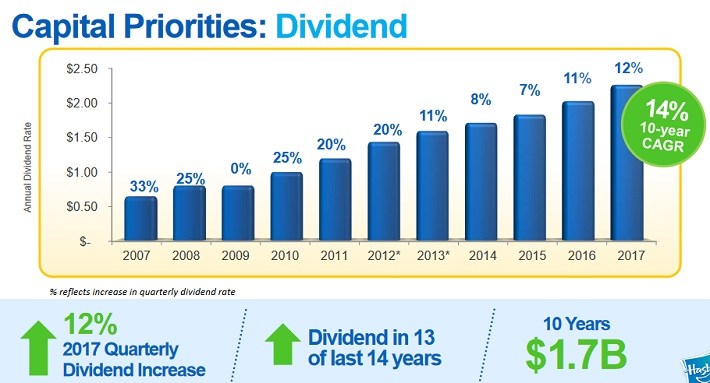Dividend stocks can generally be separated into two groups. The first group is made up of high-yield stocks. Think telecoms and utilities, which offer higher dividend yields of 4%+. Their high yields are attractive, but the trade-off is that they tend to have low dividend growth rates. Sometimes, their dividend increases barely beat inflation.
The second group is made up of stocks that have lower dividend yields, in the ~2% range, but have high dividend growth rates. These companies typically distribute a lower percentage of their earnings today, so that they can invest in the business to generate growth. The trade-off with these stocks, is that they can raise their dividends 10% each year or more, in some cases.
Investors on the hunt for high-quality dividend growth stocks should review the list of Dividend Achievers, which have raised dividends for 10+ years in a row. You can see the entire list of all 265 Dividend Achievers here.
Dividend growth stocks with lower yields may not appeal to retirees, who might want more income right now, but they are well-suited for young investors with longer time horizons. Over time, a portfolio of these stocks can build higher dividend income streams than stocks with high current yields, but low dividend growth rates.
This article will discuss the top 10 dividend stocks for young investors.
Long-Term Dividend Growth Stock #10: Hasbro
Hasbro (HAS) is a good fit for young investors, as it has increased its dividend by 14% each year over the past 10 years. This includes a 12% dividend increase earlier this year. The company has raised its dividend for 13 out of the last 14 years, and is on the list of Dividend Achievers.

Source: 2nd Quarter Earnings Presentation, page 18
Its high dividend growth rates are the result of strong cash flow. Hasbro generated $620 million of free cash flow in 2016, a 51% increase from the previous year.
The company enjoyed broad-based growth last year. All of its core operating segments posted growth, including 15% revenue growth in the U.S. and Canada, 11% international growth, and 8% growth in Entertainment and Licensing revenue. This drove record revenue and earnings for the company in 2016, surpassing $5 billion in sales for the first time.
Hasbro is off to a great start to 2017. Total revenue increased 7% over the first half, to $1.82 billion. Revenue increased 11% in the second quarter, led by 16% growth in the U.S. and Canada.

Source: 2nd Quarter Earnings Presentation, page 7
Hasbro should continue to grow over the long term. It is one of the top global entertainment companies, with popular brands across toys, games and its upstart content business. Some of the company’s brands include Nerf, My Little Pony, Transformers, Play-Doh, Monopoly, and Magic: The Gathering. Hasbro Studios also produces content.
Hasbro’s Franchise Brands, its largest segment, grew revenue by 21% in the second quarter, thanks to strong growth from Transformers, Magic: The Gathering, Nerf, and Monopoly. The company will also benefit from international growth. Hasbro has a great deal of opportunity in the emerging markets. Currency-neutral revenue rose 5% and 9% in Latin America and the Asia-Pacific segments over the first half, respectively.
Hasbro stock yields 2.4% right now, which is still above the S&P 500 average. With a dividend payout ratio below 50% and a long growth trajectory ahead, Hasbro has a good chance at delivering 10%+ compound annual dividend growth for many years.
Long-Term Dividend Growth Stock #9: Costco Wholesale
Costco’s (COST) current dividend yield is just 1.3%, well below the 2% average yield in the S&P 500 Index. However, Costco is a much more appealing dividend growth stock than the current yield indicates. It delivered an 11% dividend raise earlier this year. Since it initiated a dividend in 2004, it has increased the dividend by 13% annually. And, Costco pays a special dividend on occasion, including a $7.00 per share special dividend for 2017.
You may have heard about the death of retail, but Costco has proved otherwise. It has continued to grow, even in a very competitive retail environment. Last quarter, total sales increased 8%, thanks to 5% growth in comparable-store sales. It has fought off the competitive threat of e-commerce giant Amazon.com (AMZN) with a focus on low prices.
Costco’s competitive advantage is its popular membership program, which has grown rapidly over the years.

Source: 2016 Annual Report, page 3
The highly lucrative Gold Star membership program grew by 38% from 2012-2016. Membership growth drives higher membership fees, which is a significant portion of Costco’s revenue base. For example, membership fees rose by 4% last quarter. Renewal rates continue to be strong, with 90.2% renewal last quarter in the U.S. and Canada.
And, Costco has invested in an e-commerce business of its own. E-commerce sales increased 15% in 2016, and rose 26% in August. Costco continues to invest in growth initiatives to keep up with the changing retail environment. Earlier this year, the company announced a partnership with grocery delivery service Shipt. Costco plans to bring the service to as many as 50 markets by the end of this year.
Overall, Costco’s earnings-per-share increased 12% through the first three quarters of its current fiscal year. Double-digit earnings growth should allow for high dividend growth rates, and regular special dividends moving forward.
Long-Term Dividend Growth Stock #8: Visa
Visa (V) has a very low dividend yield, of 0.7%. A dividend yield less than 1% might be an automatic disqualifier among income investors who focus on high yields. However, even a tiny dividend yield can grow to a high yield over time, especially given Visa’s high dividend growth potential.
Over the past five years, Visa has increased its quarterly dividend by approximately 24% per year, on average. At this rate, Visa’s dividends will double every three years. If Visa can maintain a 24% annual dividend growth rate, investors would earn a 6% yield on cost in 10 years.













Leave A Comment